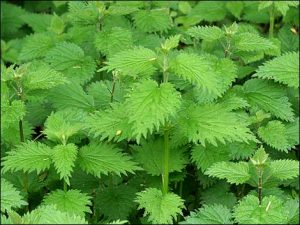 Urtica dioica, or stinging nettles, grows in the wild throughout most of North America, Europe, Asia, and Northern Africa. Found in shady areas with moist soil, such as along rivers, lakes, ditches, and fence-rows, dense clusters of nettles can grow to heights of eight feet at maturity. Their green leaves are jagged, with pointed tips and “hairs”- whisper-thin projections that adorn the leaves’ surfaces and contain irritants such as formic acid and histamine. It is these hairs that give stinging nettles their name and that can make working with these plants tricky.
Urtica dioica, or stinging nettles, grows in the wild throughout most of North America, Europe, Asia, and Northern Africa. Found in shady areas with moist soil, such as along rivers, lakes, ditches, and fence-rows, dense clusters of nettles can grow to heights of eight feet at maturity. Their green leaves are jagged, with pointed tips and “hairs”- whisper-thin projections that adorn the leaves’ surfaces and contain irritants such as formic acid and histamine. It is these hairs that give stinging nettles their name and that can make working with these plants tricky.
Stinging nettles are often added to tinctures and teas for pregnancy and postpartum issues. They are also an excellent remedy for springtime allergies. Below you will find instructions on how to harvest nettles safely and a recipe for nettle pesto. Enjoy!
Harvesting Nettles
You will need:
- Rubber gloves
- A bag or basket
- A plant identification book
Harvest nettles several weeks after they appear in early Spring. Wearing rubber gloves, pick the leaves from the tops of the plants and place in a bag or basket. Note: never harvest after flowers appear, as the plant harvested at this time can cause urinary tract irritation.
To use your nettles, fill a large bowl with cold water. Wearing gloves, pull the harvested plants out of the bag and submerge them in the cold water for five minutes. Pull leaves from the stems of the nettles and place the leaves in boiling water for one minute. Let nettles cool and then chop into pieces.
Nettle Pesto
2/3 cup of chopped nettles
¼ cup of Pecorino Romano cheese
3 cloves of garlic
½ cup of pine nuts
½ olive oil
salt and pepper
Place all ingredients into a food processor and process until a paste is formed. Transfer to a clean jar. Use pesto on vegetables, pasta, bread, etc.
References
Tilgner, Sharol, Herbal Medicine from the Heart of the Earth, Wise Acres Publishing, 2009, p 126.
Written by Kaitlyn Pote, NUNM Naturopathic Medicine Program

